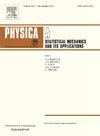在等效维度空间中显示的Mw7.0 2020希腊萨摩斯主震前的聚类迹象
IF 2.8
3区 物理与天体物理
Q2 PHYSICS, MULTIDISCIPLINARY
Physica A: Statistical Mechanics and its Applications
Pub Date : 2025-06-16
DOI:10.1016/j.physa.2025.130777
引用次数: 0
摘要
在分析2020年希腊萨摩斯Mw7.0级主震的准备阶段时,将等效维度转换为研究地震过程的新方法。该分析考虑了2006年至2020年10月之间的地震,就在主震发生之前,覆盖的区域是主断裂长度的三倍。地震发生时间、震中地理坐标和震级被用来评估由震级、等待时间(自上次地震以来的间隔时间)和震中偏移量(这次地震和上次地震的震中之间的距离)组成的三联体。将这些新参数转换为等效维度后,它们的三元组就成为[0,1]立方体中的点。这些点与地震发生的时间相联系。这些点之间的平均距离是在连续50个事件数据窗口内计算出来的,用于跟踪地震过程的演变。结果显示,在主震发生前的12年间,平均距离呈稳定增长的趋势。这些平均距离的时间变化是由{震级、等待时间、震中偏移}点聚类的系统演化所驱动的。在其他强震情况下也观察到{震级、等待时间、震中偏移}点之间的平均距离的类似行为。这表明,跟踪这些地震过程的新参数化之间的平均距离的时间变化也可能在未来增加地震预报方法。本文章由计算机程序翻译,如有差异,请以英文原文为准。
Clustering indications before the Mw7.0 2020 Samos, Greece, main shock as revealed in an equivalent dimensions space
The transformation to equivalent dimensions, which offers a novel approach for investigating seismic processes was engaged in analyzing the preparatory phase of the 2020 Samos, Greece, Mw7.0 main shock. The analysis considered earthquakes between 2006 and October 2020, just before the main shock occurrence, covering an area extended three times the length of the main rupture. The earthquake occurrence times, epicentral geographical coordinates, and magnitudes were used to evaluate triplets comprising the magnitudes, waiting times – the intervals since the previous earthquake, and epicentral offsets – the distances between the epicenters of this and the previous earthquake. After transforming these new parameters into equivalent dimensions, their triplets became points in the [0,1] cube. The points were linked to the times of earthquake occurrences. The average distance between these points, calculated within consecutive 50–event data windows, was used to track the evolution of the seismic process. Results revealed a distinct pattern, in which the average distance was increasing steadily during the twelve-year period before the main shock. These temporal changes in the average distance were driven by a systematic evolution of the {magnitude, waiting time, epicentral offset} points clustering. Similar behavior of the average distance between the {magnitude, waiting time, epicentral offset} points was also observed in other strong earthquake cases. This suggests that tracking the time changes of the average distance between such new parameterizations of the earthquake process may also add, in the future, to earthquake forecasting methods.
求助全文
通过发布文献求助,成功后即可免费获取论文全文。
去求助
来源期刊
CiteScore
7.20
自引率
9.10%
发文量
852
审稿时长
6.6 months
期刊介绍:
Physica A: Statistical Mechanics and its Applications
Recognized by the European Physical Society
Physica A publishes research in the field of statistical mechanics and its applications.
Statistical mechanics sets out to explain the behaviour of macroscopic systems by studying the statistical properties of their microscopic constituents.
Applications of the techniques of statistical mechanics are widespread, and include: applications to physical systems such as solids, liquids and gases; applications to chemical and biological systems (colloids, interfaces, complex fluids, polymers and biopolymers, cell physics); and other interdisciplinary applications to for instance biological, economical and sociological systems.

 求助内容:
求助内容: 应助结果提醒方式:
应助结果提醒方式:


